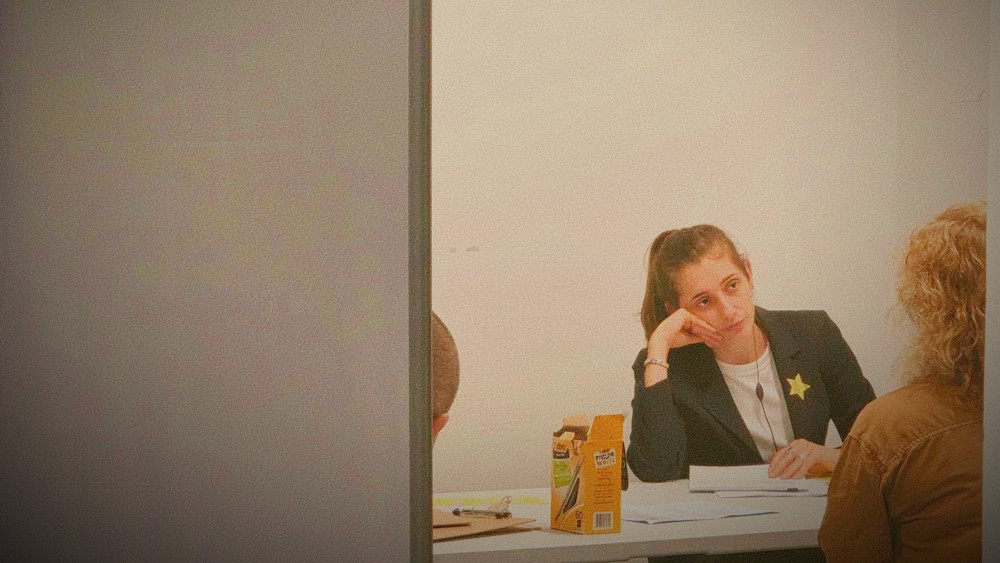Melted. Jailed. Eaten. Burned. Reformed. Disappeared. Contained. Destroyed. Changed. What happened the villain in your favorite movie as a child?
Melt.Punish isolates these moments of reckoning as locations of narrative and semiotic inquiry. It asks: What system of justice is implied by this result? How might we read the “text” of the image of this punishment? What is the story lurking underneath the story here?
The play collects this information and projects it back onstage through a kaleidoscope of deranged social media posts, surreal confessionals, and quiet horror fables true and not. It’s a phantasmagoria exploring American attitude on media and culture, splayed out onto two bodies with a fraught power relationship of their own. I won’t say much more about the literal plot so as not to spoil the fun. But there is a plot. (Thank God, right.)
The research and development of the piece existed in two branches: the semiotic investigation and the interviewing sessions.
DECONSTURCTION
The working, non-academic definition of semiotics as it relates to this project is as follows: The understanding of an image or sequence of images as a ‘text’ made up of a series of signs, these signs possessing connotative and denotative meaning. The deconstructive process for the play involves isolating these signs and their related meanings and using them as raw materials for the building of the play.
For example, The Evil Queen in Snow White.
She falls to her death.
(And then she’s crushed by a boulder.)
A deconstructive reading of this image as a might focus on the craggy environment, the boulder, the rain (water is everywhere in punishment), her black clothing, her troubling nose, the unseen lightning bolt which caused the fall (cosmic punishment), her dual identity – or the act of falling itself, which is a fate befalling many, many children’s move villains. It’s so common an occurrence that there are compilations of it on YouTube. (Who these compilations are for and why they are watched feels related to the project of this play, but I honestly couldn’t tell you.)
I’ve come up with a working theory as to the reason falling to death is so commonplace among children’s movie villains:
a. It obscures the moment of violence.
b. It creates deniable culpability for the character we’re meant to identify with.
c. It leaves the possibility for return open, in case that is financially viable.
Which feels not entirely unrelated to the American imperial project, right? I mean it’s all a little stupid – this reading, these associations. It’s a bit like being in an English class and making meaning out of nothing. But I hope there’s usefulness or at least pleasure in the stupidity of decoding or of connotative writing. I’m after a sort-of accumulating psychic debris that comes from the figurative worlds of these stories and piles up into a play.
A great example of this psychic debris – although it stretches the definition of villain – is Skibidi Toilet. Never has a piece of media been such an on-the-nose symbolic vomit of American anxieties around surveillance, humanness, AI, militarized environments, and disgust.
A nearly non-narrative work, Skibidi Toilet concerns an ongoing war between the “Skibidi Toilets” (creatures with toilet bodies and human heads emerging from the bowl) and “Camera Heads” (creatures with human bodies and camera heads; plus, their technological allies.) Each segment features some kind of moment of violence, a song, and a contribution to ongoing story of the war between these creatures.
The popularity of Skibidi Toilet and Elf on the Shelf communicate loud and clear: Gen Alpha feels surveilled.
There’s an interesting moral element to Skibidi Toilet, which emerges with every era of children’s media, of fear-love for the central character. The creature we are meant to identify with is not behaving adaptively. Like Five Nights at Freddy’s and Slenderman before it, there is an identifying with the creature of destruction. There is a kind of fear-love; a desire to bring oneself closer to the destructive element out of some kind of inarticulable need to transgress, to show off, to submit, and process. Without too much diverting this article, I’ll say that it feels unsurprising children have latched on this work as a location of investment and interest. The popularity of Skibidi Toilet and Elf on the Shelf communicate loud and clear: Gen Alpha feels surveilled.
Some other deconstructions in the project are more narratively minded – for example in Home Alone, there’s a question of actual versus structural punishment. The Wet Bandits (more water imagery) are taken away to jail at the end of the movie, the structural punishment for their bad behavior. Anyone who has seen Home Alone, however, can tell you that the actual punishment for their bad behavior is the continued and escalating physical punishments they endure by a vigilante. (There’s also a question of – their bad behavior is technically that they’ve robbed other houses, but in reality, we’re meant to understand their bad behavior as their desire to rob Kevin’s house. Ought we punish bad desires? What is to be done about “bad” desires?) Does indulging in the pleasure of slapstick punishment offer violence as a meaningful (if non-adaptive) answer to badness? Or is the relation less one-to-one?
INTERVIEWS
The interview component of the project was conducted over the course of a year. I spoke with many people related (however obliquely) to children’s media and its discourse: Media scholars, new parents, drag queens, tv writers, right-wing book-banners, etc. Each interview started with the question ‘What happened to the villain in your favorite movie as a child?’ and the answer necessarily raised other points of inquiry.
At what point does the difference between our lived value systems and the value systems of fiction become too great?
A common response among 20–30-year-olds, for example, was The Lion King. The villain of The Lion King is Scar, who is eaten by his own henchman in the final act of the film. (Being eaten and falling to death is how many children’s media villains are punished pre-2010.) This raised questions of ‘What do you think about the death penalty?’ ‘Do you think children are able to transpose moral across barriers of identity?’ ‘How do you feel about furries?’ One interview began with a participant who could not remember the fate that ultimately befell Scar and ended with the same participant describing a (seemingly unrelated) sexual fantasy of being eaten alive. These Lion King interviews, mixed with the pseudo-semiotic breakdown of the Scar punishment – the flame, the workers consuming the boss, Scar essentially being gnashed in the teeth of the Devil à la Judas in Dante’s Inferno – became a short, shared story of mutual cannibalism in the play. At what point is the desire to punish and the desire to be punished blurred? Is total an inability to identify desire absent of punishment? At what point is a fixation on punishment an abdication of autonomy and social responsibility?
Some other common themes among the interviews included the chasm between our fictive and lived value systems and the responsibility (or not) of media as a tool of moral instruction. An acknowledged reality of this project is that there is something pleasurable about watching Marv from Home Alone get burned with an iron, even if we ourselves would never burn someone with an iron. It is pleasurable (or at least relieving) for some people to watch Hans get hauled off to jail at the end of Frozen – even if we understand the American prison system to be an unchangeably evil structure. I would never deny this difference or (worse) call such a chasm hypocrisy, but the play does take a vested interested in the blurry space between these finely walled areas. At what point does the difference between our lived value systems and the value systems of fiction become too great? Where do we draw the line with a piece of media which might, to our estimation, perpetuate harmful or anti-social behavior? (A question that came up frequently with parents was ‘What don’t you let you child watch and why?’) Relatedly, what is the obligation and/or ability of children’s media toward moral instruction? We acknowledge children’s media as a particularly salient political location in 2024 regarding the imparting of the wrong or right value systems. How do we define its ability to impart and who decides what is imparted? And does instruction exist subliminally even in the explicitly non-instructive – what is the story behind the story of Elsagate content?
FINALE
If this all sounds like pseudo-academic nonsense, it’s because it is. But how much fun is that, right? Much of the work of this year has simply been trying to go ‘stupid mode’ and make a play. (And to stop asking so many questions that lead to more questions. I feel like I asked so many unanswerable questions in the first part of this article. Sorry.) I think every play should have a kind of dangerous homemade feeling. So that’s what I’m after.
In the spirit of ‘stupid mode’, I’m going to end with some memes and a story from my life which helps me understand why I wanted to write this play.
These are the memes:

The story is this:
I have terrible insomnia.
When I can’t sleep, what I do is I go on Instagram reels. I love Instagram reels. I can’t get enough of Instagram reels. It’s pathetic. I especially love videos of large Christian families and old weird cartoons. But I often find myself coming across videos of people who are, in one way or another, behaving badly. This makes me uncomfortable. It makes me uncomfortable because it makes me unhappy to see a person behaving badly.
I don’t want to watch these videos because ultimately, they will only lead to more videos of similar behaviors being recommended – this is how the algorithm works. But I can’t seem to get myself to scroll until I know what happens to the person who is causing harm. Will they get fined? Fired? Arrested? Will someone say something witty and cutting to them? Will the comments express outrage? What will happen? And I feel satisfied if the bad behavior is resolved and unsatisfied if it isn’t. Do I care more about the punishment of the bad behavior than the restoration of the person being affected? That seems antithetical to my values. But at night when I can’t sleep, I get caught in these endless narrative traps of transgression/resolution, transgression/resolution, transgression/resolution. And I kind-of wonder what that’s all about.
Extended Play is a project of The Civilians. To learn more about The Civilians and to access exclusive discounts to shows, visit us and join our email list at TheCivilians.org.
Author
-

James La Bella (he/him) is a writer and performer from New England. He earned his BFA from Emerson College, with additional coursework completed at Harvard University. Jameslabella.com
View all posts

















